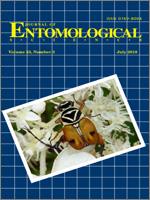Ficus microcarpa L. and F. racemosa L. are often extensively damaged by the defoliating pest Phauda flammans Walker (Lepidoptera: Zygaenidae). The structure, morphology, abundance, and distribution of the antennal sensilla of P. flammans were studied using scanning electron microscopy. Six types and eight subtypes of sensilla were observed on the filiform antennae of both sexes, including trichodea (subtypes I and II), basiconica (subtypes I and II), coeloconica, styloconica, chaetica, and Böhm bristles. The most numerous sensilla were the trichodea on the antennae of both sexes. Sexual dimorphism was observed, with the male antennae having more sensilla trichodea than the female antennae. This information is essential for understanding the electrophysiological and behavioral aspects of chemical communication in P. flammans.
How to translate text using browser tools
1 July 2018
Ultrastructural Observations of Antennal Sensilla in Phauda flammans Walker (Lepidoptera: Zygaenidae)1
J.Y. Liu,
Y.J. Zhang,
Z.Y. Huang,
Z.S. Dong,
Y.B. Duan,
W. Lu,
X.L. Zheng
ACCESS THE FULL ARTICLE

Journal of Entomological Science
Vol. 53 • No. 3
July 2018
Vol. 53 • No. 3
July 2018
antennal sensilla
Phauda flammans
scanning electron microscopy




